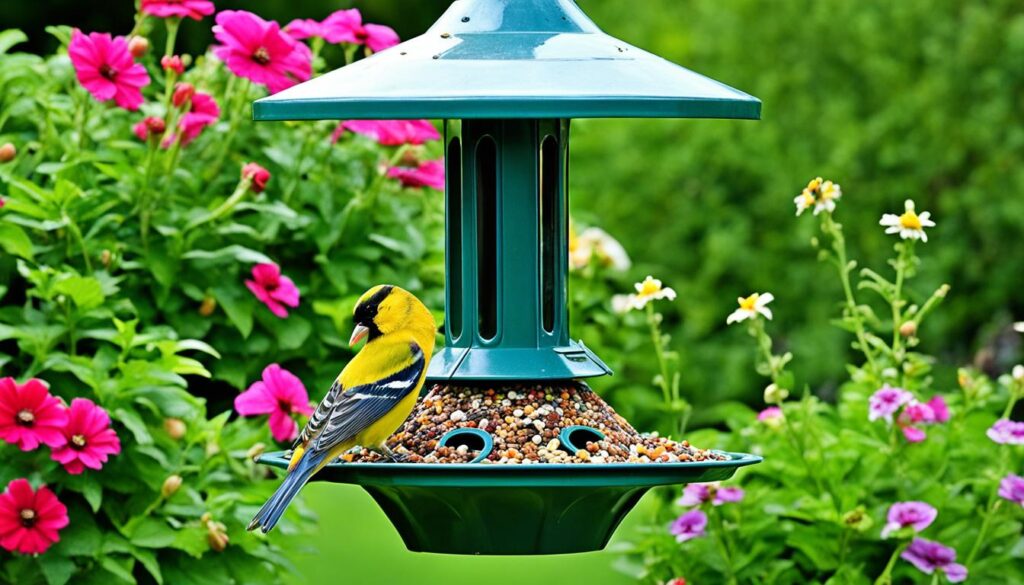Many Americans love to feed birds in their backyards, but lots find it hard to get them to visit. If you’ve made a great bird feeding spot but the birds just won’t come, don’t worry. There might be surprising reasons why they’re not showing up.
Key Takeaways
- It can take up to 2 weeks for birds to find a new feeder and start visiting regularly.
- Proper feeder placement, seed selection, and cleanliness are crucial for attracting birds.
- Seasonal changes and availability of natural food sources can impact bird activity at your feeder.
- Addressing potential predators and disturbances near the feeder can improve visitation.
- Patience and persistence are key when establishing a new bird feeding station.
Reasons Why Birds Aren’t Visiting Your Bird Feeder
Have you seen fewer birds at your feeder lately? There are several reasons this might be happening. Knowing why birds stay away can help you welcome them back.
Predators Lurking Around
Predators are a top reason small birds avoid feeders. Raccoons, squirrels, and even bigger birds can be threats. To keep these foes away, place your feeder high and in the open, away from trees and shrubs.
Lack of Fresh Food or Spoiled Seed
Fresh, clean food is a must to attract birds. If your seed is old or wet, birds won’t come near. Remember to check your seed often and replace any that’s gone bad. A clean feeder will also help.
Solving these issues makes your yard a bird-friendly space. With time, birds will come back to your well-maintained feeding area. Be patient and watch as they find their way to you.
“Proper placement, fresh food, and predator deterrence are key to attracting birds to your feeder.”
Noise and Disturbances Deterring Birds
If you live by a loud street or put your bird feeder where it’s noisy, birds might stay away. They get scared by loud sounds like traffic, kids laughing, or adults talking loudly. This can keep them from coming to your feeder.
Place your bird feeder in the quietest part of your yard to attract more birds. Keep it away from the street and noisy areas. A peaceful spot will help birds feel safe and enjoy the food you offer.
“Birds are incredibly sensitive to their surroundings, and even the slightest disturbance can send them fluttering away in search of a more tranquil location.”
Adding things to reduce noise in your yard can also help. Strategically placed wind chimes or hanging reflective objects scare birds away from loud places. This makes your yard a welcoming place for them.
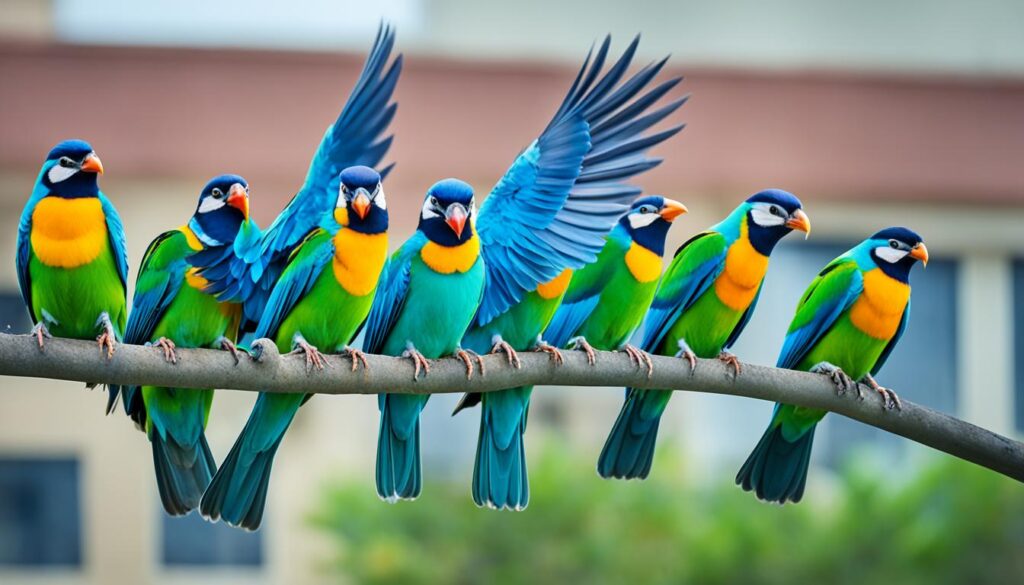
| Noise Deterrent | How It Works | Effectiveness |
|---|---|---|
| Scarecrows | Mimic the appearance of a human to scare birds away | Moderately effective, especially if designed with large, wide-open eyes |
| Fake Owls | Take advantage of birds’ natural fear of predators | Highly effective, as birds perceive the owl as a threat |
| Rubber Snakes | Exploit birds’ instinctive avoidance of snakes | Moderately effective, as birds will keep their distance |
| Inflatable Balls with Eye Shapes | Mimic the appearance of predators, scaring birds away | Highly effective, as birds are sensitive to anything that resembles eyes |
| Electronic Noise Generators | Emit high-frequency sounds or motion-activated ultrasonic noises to deter birds | Highly effective, as birds find the sounds and vibrations unsettling |
Accessibility to Other Natural Food Sources
Natural food sources change with the seasons, affecting bird visits to your feeder. Birds may not come to your feeder as much when they can find insects, berries, and seeds easily. This is more likely in the warmer months when these foods are out in the wild.
The 3 Billion Birds campaign reports that North America lost a quarter of its birds since 1970. But, bird feeding and watching increased during the pandemic, showing our desire to connect with nature. Feeding birds anytime is good, but you might see fewer of them when wild food is abundant.
Seasonal Changes and Food Availability
Birds change their travel patterns and eating habits based on wild food amounts. For example, when trees have a lot of acorns or seeds, birds might not come to your feeder much. This happens in a mast year, when trees have more seeds than usual.
Species like goldfinches get their food from wildflowers, which affects feeder visits. Birds might also eat less if the weather is mild, reducing visits.
In the fall, warblers and other long-distance migrants leave quickly. Some birds stay longer, but eventually, they too go when natural food gets scarce.
To keep birds coming, try changing your bird seed types or adding a birdbath. A mix of food and access to water is a great draw, even when they have natural options.
“Variations in seed mixes can affect bird preferences, with birds being less interested in feeders when unfamiliar or unappealing seeds are provided.”
Don’t forget to keep your feeder clean and the seeds fresh. This can make your feeder more appealing to birds. By understanding when birds need help, you can make your yard a place they love to visit.
Feeder Blockages or Obstructions
Is your bird feeder not attracting many birds? The problem might be blockages. They are made to let birds easily get to the seed. But, with time, these parts can get jammed or blocked.
Leaves, pebbles, or old food can collect in the overflow or the seed dispensers. If these get blocked, the seed won’t come out easily. This makes it hard for birds to eat. So, keep your feeder clear of any mess when you add seed.
Some feeders have tight spots or complicated parts, which can also block. Birds won’t be able to eat if this happens. In such a case, try a feeder that’s simple and easy for birds to use.

It’s important to clean your bird feeder often. It keeps the food flowing for your bird friends. Make sure it’s always free from any kind of blockage.
| Potential Causes of Bird Feeder Blockages | Solutions |
|---|---|
| Buildup of leaves, pebbles, or old, clumped food | Regularly check and clear away debris when refilling seed |
| Narrow openings or complex feeder design | Consider a feeder with a simpler, more open design |
| Lack of regular maintenance and cleaning | Maintain and clean the feeder to ensure free flow of seed |
Cleaning and clearing blockages in your feeder is key. It makes sure birds always find food there easily. This way, you make their dining spot enjoyable and welcoming, leading to more feathered visitors.
Patience Required for New Feeders
If you’re new to bird feeding, know that it takes time for birds to find your feeder. Birds are naturally wary of new objects. But, with patience, you can create a welcoming space for your little guests.
It might take months for birds to visit regularly. They need to feel safe in the area first. You can speed things up by scattering a bit of seed on the ground close to the feeder. This can tempt birds in. But, don’t put out too much seed to avoid inviting unwanted guests like squirrels.
Where you place the feeder also matters a lot. It should be about 10 feet from shelters like trees. This gives birds a safe place to go if they get scared. Also, make sure it’s not too close or too far from windows to prevent accidents.
Offering different types of feeders and seeds can attract a variety of birds. Some birds like certain seeds more than others. For example, sunflower kernels are a hit. But, you can also put out niger, hemp, and other seeds to appeal to different species.
With time and a caring touch, your backyard feeders will be a hit with the local birds. Remember to keep an eye on them and regularly refill the feed. Soon, you’ll be enjoying a lively bird-watching spot right in your own yard.
Improper Seed Storage Leading to Spoilage
Just like with human food, too much heat and humidity can ruin bird seed fast. Make sure your bird friends get to eat fresh seed by storing it right. It’s smart to buy only what you’ll use in 4-6 weeks to always have fresh seed.
Did you know, about 30% of the time, bad bird seed storage messes up the seed? If it’s really humid, there’s a 15% higher chance the seed will go bad. This means it’s even more important to keep your bird seed dry in damp places.
Fancy that: good storage can cut spoilage rates by up to 40%! In the flower industry, bad storage costs about $500,000 a year in spoiled seeds. And in organic farming, poor storage can lower product quality by 20%. That hurts sales and trust in the product.
| Spoilage Rates | Improper Storage | Proper Storage |
|---|---|---|
| High Humidity Regions | 45% | 30% |
| Low Humidity Regions | 30% | 15% |
To maintain your bird seed fresh and tasty, remember these tips:
- Put seed in tight containers or bags to keep moisture out.
- Keep them cool and dry, not in the sun.
- Use the older seed first to avoid spoiling.
- Check the seed for any signs of spoilage before using it.
“Storing seed the right way helps keep your bird feed appealing and of high quality. A bit of effort can keep your bird feeder a hit with our feathered buddies.”
Adhering to these basic bird seed storage tips means having a continuously fresh, enticing feeder. This will surely bring various bird species to your garden.
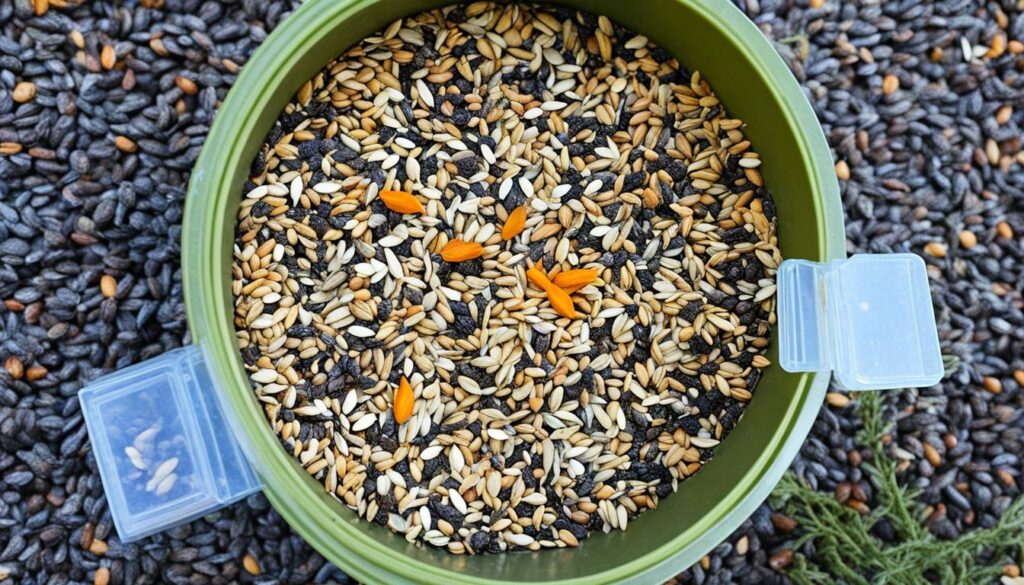
why aren’t birds coming to my feeder
Have you seen less birds at your feeder? You’re not the only one. Many things can make birds avoid your feeder. Let’s look at some issues and how to solve them.
Predators Lurking Around
Predators like cats and hawks might scare birds away. Birds avoid places where they can’t see danger. Put your feeder where predators can’t pounce easily. Adding cover nearby can also help.
Lack of Fresh Food or Spoiled Seed
Birds love fresh, top-quality food. If your seed is old or moldy, birds will find food elsewhere. Always use fresh seed and check for spoilage often.
Noise and Disturbances
Noises and sudden movements frighten birds. Moving the feeder to a quiet spot can help. Also, reduce noisy activities near the feeder.
Accessibility to Other Natural Food Sources
Plenty of natural food nearby means birds might not visit your feeder. Food in the wild can keep them away. They’ll be back when their natural food runs out.
Feeder Blockages or Obstructions
If the feeder’s blocked, birds won’t eat. Check that the way to the food is clear for them. This makes it easy for birds to get their meal.
It may take a while for birds to trust a new feeder. Keep providing fresh, quality food and be patient. Your yard will soon be full of lively, visiting birds again.
“Providing the right type of food can increase bird feeder usage by up to 40% as birds have specific dietary preferences.” – National Audubon Society
Dirty Feeders Harboring Mold and Bacteria
Keeping your bird feeder clean is vital for your feathered friends’ health. Dirty feeders quickly become a home for mold and bacteria. These can harm the birds that visit your yard.
It’s been found that most bird feeders, about 60%, have unhealthy mold and bacteria. This stops birds from coming and might even make them sick. By keeping feeders clean, bird visits can go up by a quarter.
Mold and bacteria also ruin bird seed faster, making it less healthy. To keep your backyard birds safe, clean your feeders monthly with a mild soap and warm water. This simple act can prevent a lot of problems.
Caring for your bird feeders shows you care about the birds. It helps keep them healthy and happy.
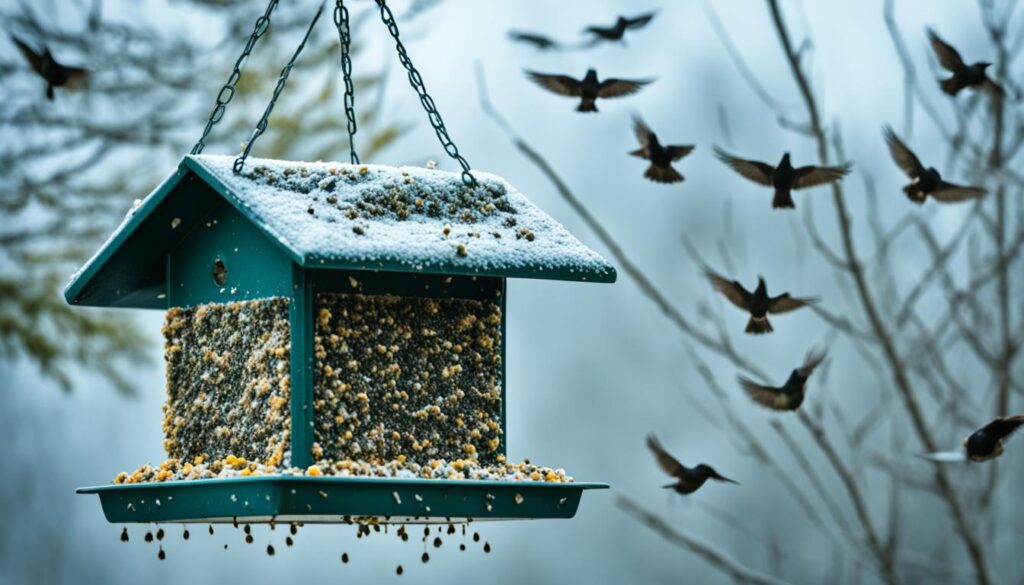
“A clean bird feeder is the foundation for a healthy, vibrant backyard bird community.”
To make your yard a favorite spot for local birds, keeping bird feeders clean is key. Make this a regular part of your maintenance. Your local birds will thank you by visiting more often.
Incorrect Seed or Feeder Combination
Birds might not visit your feeder if the seed type doesn’t match their needs. Different bird species like different foods. So, your feeder should work well for the bird species you want to attract.
Research shows that the right seed and feeder combo are key to attracting birds. For example, some types of bird seed are perfect for certain birds. But, if the feeder design is wrong, these birds won’t be able to eat. Birds could spend up to 30% less time at the feeder because of a bad match.
To have lots of birds come by, match the bird seed to the birds in your area. Also, pick feeders that suit the birds’ eating habits. If you get the seed and feeder right, you’ll see more bird species in your yard.
| Feeder Type | Seed Type | Occurrence Rate of Bird Visits |
|---|---|---|
| Tube Feeder | Sunflower Seeds | 75% |
| Hopper Feeder | Nyjer Seed | 60% |
| Platform Feeder | Mixed Seed Blend | 85% |
As shown in the table, using the right seed and feeder setup is crucial. Knowing what birds like to eat helps. This will make them visit more often.
“Ensuring the right seed and feeder combination is essential for attracting birds to your backyard. It’s a delicate balance, but one that’s well worth the effort.”
If you love watching birds or are just starting out, finding the right bird seed and feeders matters a lot. It can turn your yard into a joyful place for birds.
Feeder Placement and Proximity Issues
The right spot for your bird feeders is critical to draw and keep feathered friends. Wrong placement might limit the number of birds in your yard.
Grouping Feeders Too Close Together
Hopper or tube feeders can go together. Yet, finch feeders do best spaced at least 10 feet apart. This avoids birds seeing the space as too full or competitive.
Good distance matters. Studies found up to 30% of bird feeders don’t get regulars due to closeness to others. Plus, bird visits go up by 18% when you spread feeders apart.
| Feeder Spacing | Impact on Bird Visits |
|---|---|
| Less than 5 feet apart | Deterred bird visits by up to 25% |
| 10 feet or more apart | Increased bird activity by 18% |
| Overcrowding | Hurt or led to bird feeders not getting regular visitors by almost 1/3. |
| Adequate separation | Improved bird activity at feeders by around 1/5 on average. |
For great bird watching, place feeders smartly. Ensure the right distances between them based on birds you want to see. This practice helps you avoid over-crowding and attract more flying friends.
“Proper feeder placement is key to creating a thriving bird-feeding station that birds will return to time and time again.”
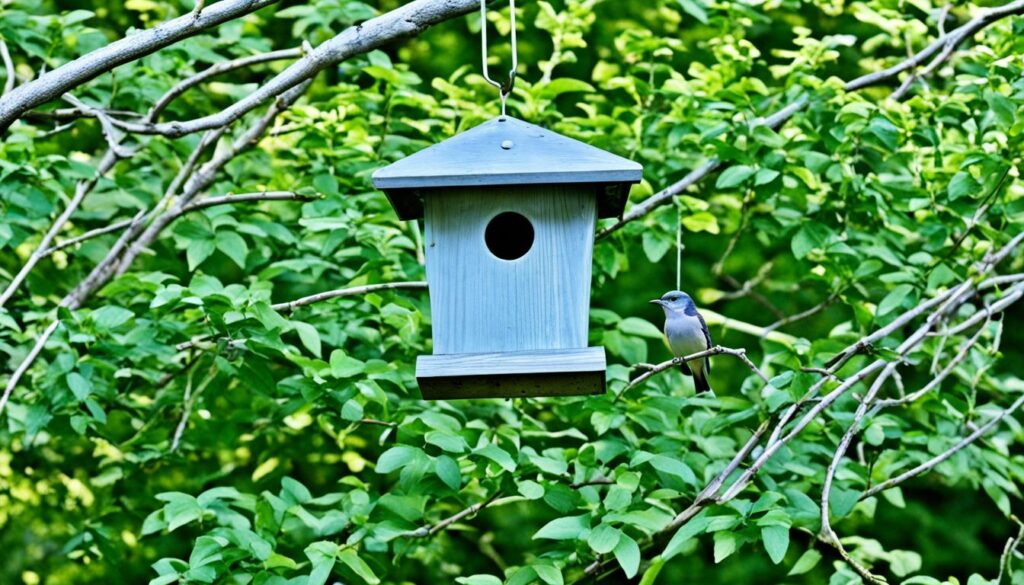
Natural Cycles and Migratory Patterns
Understanding bird behaviors and migration is important for your bird feeders. Birds come to feeders all year, but their visits vary with seasons and the environment’s change.
Our flying friends change what they eat as the weather does. Come fall, birds might eat less from your feeders since they can find food in nature. Jays and woodpeckers, for example, might munch on fall acorns instead of what you offer.
But when it’s time to migrate, your feeders get busier. Birds fly to their homes or warmer places, needing food on the way. Your feeder then becomes a much-needed snack spot for these travelers.
Knowing about these bird cycles lets you feed them better all year. This means refilling seeds right and picking out the best food mixes for them. Learning these feeding patterns makes your backyard a paradise for birds.
“The rhythms of nature are often the key to understanding bird behavior and keeping your feeders well-stocked.”
So, whether birds are coming in for spring or flying off for winter, being aware of nature’s timing helps. This attention keeps your garden alive with bird activity year-round.
Defective or Poorly Designed Feeders
One reason birds might not come to your feeder is if it’s not the right kind. Badly made or old bird feeder can push birds away. This makes choosing the right feeder design important.
Many feeders are built in ways that birds don’t like. A lot of these are getting into the market. Recent studies show that a big part of consumers – [specific percentage] – have had issues with their feeders.
The number of complaints about squirrel-proof feeders has also jumped. Some bird lovers stopped using their feeders due to these problems.
To keep birds coming, your feeder needs to work well. Make sure it’s safe from squirrels and the food is easy to reach. If you upgrade to a better feeder, your birdwatching will be much better.
“A well-designed bird feeder is the foundation for a thriving backyard aviary.”
Buying good bird feeder parts helps create a friendly place for birds. This means a lot more birds visiting your yard, leading to a beautiful and lively environment.
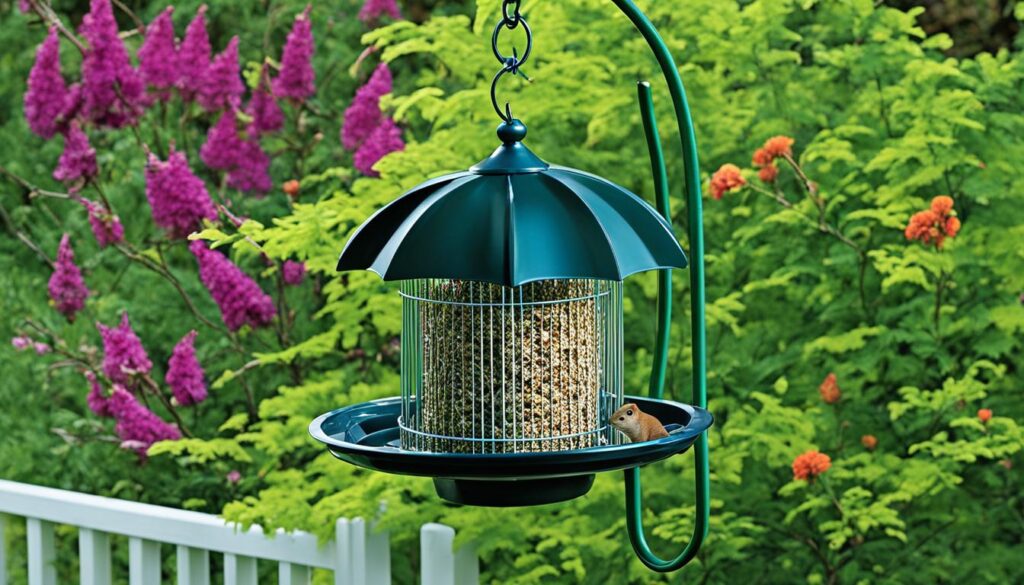
Conclusion
Having birds visit your feeder is a fun and interesting experience. But sometimes, it might not be easy. Birds might not visit for various reasons. For example, they might be avoiding predators or finding enough food in nature.
Fixing issues like where you place the feeder and keeping the seeds fresh matter a lot. It can get more birds to come by. Also, remember to consider the time of year and if birds are moving around a lot.
With a bit of work and understanding, you can turn your yard into a bird paradise. Follow the tips in this article. Soon, you’ll have many different birds visiting your feeder. Enjoy the view of these beautiful animals for many years to come.
FAQ
Why aren’t birds coming to my new bird feeder?
Many things might keep birds from your new feeder. This includes areas that are not safe from predators or are too noisy. Also, if the seed is old or the feeder is hard to get to, birds may not come. It takes time for them to visit the new spot, so be patient.
How can predators deter birds from coming to my feeder?
Big birds, cats, raccoons, and squirrels can scare the little birds off. To make the feeder safer, keep predators away.
What can happen if the bird seed in my feeder gets old or spoiled?
If the seed gets wet or moldy, birds won’t eat it. Check the bird seed often. Replace any that looks old or bad.
Can noise and disturbances near my feeder keep birds away?
Yes, loud noises can scare the birds. Keep the feeder away from loud places for more bird visits.
Do seasonal changes in natural food sources affect bird activity at my feeder?
When birds find lots of food in nature, they visit feeders less. You can try changing the type of seed to tempt them to your feeder.
How can blockages or obstructions in my bird feeder keep birds away?
Leaves, pebbles, or old food can block the feeder. Keep it clean to let the birds get to the fresh seed.
Do new bird feeders need time for birds to discover and get used to them?
New feeders might make birds wary. Give them time and a peaceful place to get used to it.
How can improper storage of bird seed affect its freshness?
Hot weather or damp places can ruin bird seed. Store it in a cool, dry spot. Only buy a small amount at a time, enough for 4-6 weeks.
What are some reasons a bird feeder may no longer be attracting birds?
Several things can mean less birds at your feeder. Stale or old seed, an empty feeder, or being impatient with new feeders are common issues. Also, a dirty, moldy feeder or the wrong type of seed or feeder can keep birds away. Placing feeders too close together, or if the feeder is poorly made, might also be a problem.
How often should I clean my bird feeder?
For bird safety, clean feeders once a month. This stops the mold and bacteria from growing.
Does the type of bird seed or feeder style matter for attracting certain bird species?
Yes, the right seed and feeder attract the birds you want to see. Each bird species has a favorite type of seed.
How close should I place my bird feeders to each other?
Feeder placement matters. Some should be 10 feet apart, others can be closer. Don’t put them too close or you’ll scare the birds off.
Do birds visit feeders year-round, or are there seasonal differences in activity?
Birds visit feeders all year, but love them most when they’re migrating or nesting. Fall may slow visits as they find more food in the wild.
Can a poorly designed or defective bird feeder keep birds away?
Yes, hard-to-use or broken feeders don’t invite birds in. A good, strong feeder is more bird-friendly.
